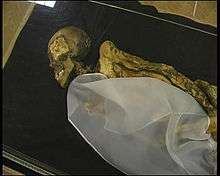Pazyryk culture

The Pazyryk culture is a Scythian[1] Iron Age archaeological culture (c. 6th to 3rd centuries BC) identified by excavated artifacts and mummified humans found in the Siberian permafrost, in the Altay Mountains, Kazakhstan and nearby Mongolia. The mummies are buried in long barrows (or kurgans) similar to the tomb mounds of western Scythian culture in modern Ukraine. The type site are the Pazyryk burials of the Ukok Plateau.(NOVA 2007) Many artifacts and human remains have been found at this location, including the Siberian Ice Princess, indicating a flourishing culture at this location that benefited from the many trade routes and caravans of merchants passing through the area.(State Hermitage Museum 2007) The Pazyryk are considered to have had a war-like life.(Jordana 2009)
Other kurgan cemeteries associated with the culture include those of Bashadar, Tuekta, Ulandryk, Polosmak and Berel. There are so far no known sites of settlements associated with the burials, suggesting a purely nomadic lifestyle.
DNA samples recovered from the remains of two Pazyryk males showed them to be members of Y-chromosome haplogroup N1b-P43.[2]
See also
References
Citations
| Wikimedia Commons has media related to Pazyryk. |
Sources
- Jordana, Xavier (2009). "The warriors of the steppes: osteological evidence of warfare and violence from Pazyryk tumuli in the Mongolian Altai". Journal of Archaeological Science. 36 (7): 1319–1327. doi:10.1016/j.jas.2009.01.008.
- NOVA (2007). "Ice Mummies: Siberian Ice Maiden". PBS - NOVA. Retrieved 2007-07-31.
- State Hermitage Museum (2007). "Prehistoric Art - Early Nomads of the Altaic Region". The Hermitage Museum. Retrieved 2007-07-31.
- Сергей Иванович Руденко (Sergei I. Rudenko) (1970). Frozen Tombs of Siberia: The Pazyryk Burials of Iron Age Horsemen. University of California Press. ISBN 978-0520013957.
External links
- Nomadic Art of the Eastern Eurasian Steppes, an exhibition catalog from The Metropolitan Museum of Art (fully available online as PDF), which contains material on Pazyryk culture